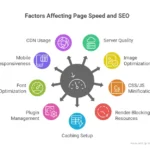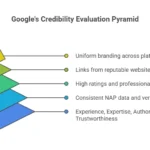SEO has changed a lot over the years. In the early days, websites could rank just by repeating keywords again and again. But Google’s algorithms became smarter. Today, search engines focus on understanding meaning, context, and user intent instead of just counting keywords.
This shift made meaningful content the foundation of SEO. It’s not about how many times a keyword appears — it’s about how well the content helps the user. Google wants to rank pages that answer real questions, solve problems, and add value.
With AI systems like RankBrain, BERT, and the Helpful Content Update, Google now evaluates how useful and relevant a page truly is. Websites that create authentic, insightful, and clear content perform better in organic search.
Meaningful content builds trust and authority. It engages readers, attracts backlinks naturally, and signals expertise to both users and search engines. In modern SEO, value beats volume — and clarity beats complexity.
What Is Meaningful Content in SEO
Meaningful content is content that truly helps the reader. It goes beyond keywords and focuses on giving clear, relevant, and useful information that answers the user’s intent.

In SEO, meaningful content connects three important elements:
- User intent – what the person is really looking for
- Topical relevance – how closely the content matches that topic
- Value delivery – how well it solves a problem or provides insights
Key Traits of Meaningful Content
- Clarity – The message is simple and easy to understand.
- Depth – It covers the topic completely, not just surface details.
- Relevance – It matches the search intent and audience needs.
- Trust – It uses facts, data, or expert sources to build credibility.
- Engagement – It keeps users reading, interacting, and sharing.
Unlike keyword-heavy content, meaningful content is created for humans first and optimized for search engines later. It uses natural language, related entities, and context to make the writing sound genuine and helpful.
Meaningful content also reflects experience and expertise. When a page provides clear answers, helpful examples, or unique insights, users stay longer — and Google notices that engagement.
In short, meaningful content is content that educates, informs, or solves a problem better than others. It’s what Google’s ranking systems now prefer.
How Google Understands Meaningful Content
Google has evolved far beyond counting keywords or backlinks. Today, it uses advanced AI and natural language processing (NLP) to understand the real meaning of content and how well it satisfies user intent.
Here’s how Google evaluates meaningful content through its major algorithm systems:
1. RankBrain – Understanding User Intent
RankBrain helps Google interpret search queries, even when users don’t type exact keywords. It studies patterns in behavior — like clicks, time on page, and bounce rate — to learn which results actually solve the user’s problem.
If visitors stay longer and engage with your page, Google reads that as a positive signal.
2. BERT and MUM – Understanding Context and Language
BERT (Bidirectional Encoder Representations from Transformers) helps Google understand the context of words in a sentence.
For example, it can tell the difference between “how to book a hotel” and “how to get a hotel booking confirmed.”
MUM (Multitask Unified Model) goes further by understanding complex queries, comparing information across formats, and even across languages.
This means Google now values content that is clear, structured, and contextually rich.
3. Helpful Content Update – Prioritizing People-First Pages
This update focuses on rewarding content written for humans, not algorithms.
It targets pages that are created mainly to manipulate rankings rather than to inform or help readers.
Meaningful content follows a people-first approach — written with the reader’s needs, not search bots, in mind.
4. EEAT – Experience, Expertise, Authoritativeness, and Trustworthiness
EEAT is now a strong quality signal.
Google looks for content written by credible authors, backed by real experience and accurate information. Sites with transparent authorship, citations, and strong topical authority rank better.
In short, Google’s AI systems can now understand meaning, emotion, and usefulness, not just keywords.
To rank well, your content must demonstrate intent alignment, trust, and clarity — all of which define meaningful content.
Elements That Make Content Meaningful
Creating meaningful content is not just about writing more words. It’s about building trust, clarity, and connection with the audience while meeting Google’s quality signals.
Here are the key elements that make content truly meaningful in SEO:
1. Relevance to Search Intent
Every piece of content must match what users want to know or do.
If someone searches “how to improve SEO,” they expect practical steps, not theory.
Matching intent — informational, navigational, or transactional — is the foundation of meaningful content.
2. Depth and Completeness
Google rewards content that fully explains a topic.
Cover subtopics, use examples, and answer related questions.
Depth shows authority and satisfies users, reducing the need to search again.
3. Clarity and Simplicity
Complex words or long paragraphs confuse readers.
Meaningful content uses clear, short, and direct sentences that even beginners can understand.
This improves engagement and dwell time.
4. Originality and Perspective
Copying or rewriting existing content doesn’t add value.
Add your own analysis, insights, data, or experience.
Google’s systems can identify originality, so fresh ideas stand out in rankings.
5. EEAT Signals
Show Experience, Expertise, Authoritativeness, and Trustworthiness.
Include author bios, credible sources, references, or real case studies.
These signals make your content more trustworthy in Google’s eyes.
6. Structure and Readability
Organized content is easier to read and understand.
Use headings, bullet points, short paragraphs, and visuals.
A well-structured page helps both readers and search engines scan content quickly.
7. Engagement and Value Delivery
Encourage users to act — by sharing, commenting, or exploring more.
Engagement shows that the content is useful.
Meaningful content always leaves the reader feeling they gained something valuable.
In short, meaningful content combines usefulness, clarity, and credibility. It answers questions completely, builds trust, and delivers a satisfying reading experience.
How to Create Meaningful SEO Content
Creating meaningful content is a mix of research, empathy, and optimization. You need to understand your audience, their problems, and how your content can give them the best answers.
Here’s a step-by-step guide to doing it the right way:
1. Start with User Intent Research
Before writing, identify what users really want to know.
Use tools like Google’s “People Also Ask”, Search Console, or Keyword Planner to understand common questions.
Focus on the intent behind searches — not just the keywords.
2. Build Topical Depth and Entity Relevance
Google now uses entity-based search, not just keyword matching.
Cover related topics, terms, and sub-entities to show deep understanding.
For example, a post about “SEO tools” should also mention “keyword tracking,” “technical audits,” and “link analysis.”
3. Write for Humans First, Optimize Later
Meaningful content speaks directly to the reader.
Use simple, conversational language and short paragraphs.
After writing, optimize headings, meta tags, and internal links naturally.
4. Use Data, Examples, and Real Insights
Add case studies, research figures, or examples from experience.
Google’s algorithms prefer evidence-backed content that proves expertise and builds trust.
5. Maintain a Clear and Logical Structure
Organize information under proper H2 and H3 headings.
Use lists, visuals, and tables to make complex topics easy to scan.
6. Optimize for Engagement
Encourage users to interact. Add CTAs like “learn more,” “download a guide,” or “read related topics.”
Engagement metrics — clicks, scrolls, and time on page — help Google evaluate value.
7. Add EEAT-Boosting Elements
Include author bios, organization details, references, or links to credible sources.
These show authenticity and improve trust signals.
8. Measure and Improve
Track how your content performs in Google Analytics, Search Console, or Looker Studio.
Look at engagement metrics, rankings, and conversion data.
Update and expand content regularly to stay relevant.
Meaningful content is a continuous process. It’s not about producing more — it’s about creating better, more valuable information that aligns with user intent and Google’s evolving AI understanding.
How SEO Professionals Should Approach Content Creation
For SEO professionals, creating meaningful content means balancing data-driven optimization with human-centered communication. It’s about writing for both — algorithms and audiences — without losing authenticity.
Here’s how SEO professionals can approach it effectively:
1. Focus on the User, Not Just the Keyword
Keywords are still important, but intent matters more.
Before writing, ask — “What is the user trying to achieve with this search?”
Build your content to give that answer in a simple, complete way.
2. Combine SEO Data with Human Insight
Use keyword data, search trends, and SERP analysis to identify opportunities.
Then, apply empathy and storytelling to make the message relatable.
This combination makes content rank well and connect emotionally.
3. Align with Google’s EEAT and Helpful Content Guidelines
Google’s algorithms now measure the helpfulness of a page.
SEO professionals should ensure every article shows experience, expertise, and value — not just optimization.
Avoid thin, AI-spun, or repetitive content.
4. Build Topical Authority Gradually
Instead of publishing scattered posts, create topic clusters that cover an area completely.
Internal linking between related articles helps Google understand your site’s expertise in that subject.
5. Audit and Refresh Content Regularly
Meaningful content stays fresh.
Update stats, examples, and insights often to match current trends or algorithm updates.
This shows reliability and ongoing expertise.
6. Use Analytics to Guide Improvements
Track metrics like dwell time, bounce rate, and returning visitors.
If users spend more time reading your content, it’s a clear sign of meaning and satisfaction.
7. Keep a Human Touch in the AI Era
AI tools can help generate ideas and outlines, but the human voice builds trust.
SEO professionals should use AI for support, not replacement — adding real opinions, stories, and experiences.
Meaningful content is where SEO strategy meets genuine communication. It’s the skill of translating technical optimization into human value — and that’s what builds authority in the long run.
Conclusion: The Future of Meaningful Content in AI Search
The future of SEO belongs to those who create content with purpose and clarity. As Google moves deeper into AI-powered search with systems like SGE and MUM, the focus is no longer on how much content you publish, but on how meaningful each piece is.
Meaningful content connects information, intent, and experience. It helps users achieve what they came for — quickly and clearly. AI-driven search systems now analyze not just keywords, but the depth, tone, and usefulness of every page.
For SEO professionals, this means content strategy must shift from “ranking” to “helping.” Every article should:
- Solve real user problems
- Demonstrate genuine experience or expertise
- Deliver a smooth and satisfying reading experience
Websites that follow this approach will earn stronger engagement, better visibility, and long-term trust.
In AI search, meaningful content isn’t just an SEO tactic — it’s the core of digital relevance and authority.

